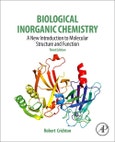Biological Inorganic Chemistry: A New Introduction to Molecular Structure and Function, Third Edition, provides a comprehensive discussion of the biochemical aspects of metals in living systems. The fascinating world of the role of metals in biology, medicine and the environment has progressed significantly since the very successful Second Edition of the book published in 2012. Beginning with an overview of metals and selected nonmetals in biology, the book supports the interdisciplinary nature of this vibrant area of research by providing an introduction to basic coordination chemistry for biologists and structural and molecular biology for chemists.
Having built this accessible foundation, the book progresses to discuss biological ligands for metal ions, intermediary metabolism and bioenergetics, and methods to study metals in biological systems. The book also covers metal assimilation pathways; transport, storage, and homeostasis of metal ions; sodium and potassium channels and pumps; magnesium phosphate metabolism and photoreceptors; calcium and cellular signaling; the catalytic role of several classes of mononuclear zinc enzymes; the biological chemistry of iron; and copper chemistry and biochemistry.
In addition, the book discusses nickel and cobalt enzymes; manganese chemistry and biochemistry; molybdenum, tungsten, vanadium, and chromium; non-metals in biology; biomineralization; metals in the brain; metals and neurodegeneration; metals in medicine and metals as drugs; and metals in the environment. Now in its Third Edition, this popular and award-winning resource highlights recent exciting advances and provides a thorough introduction for both researchers approaching the field from a variety of backgrounds, as well as advanced students.
Please Note: This is an On Demand product, delivery may take up to 11 working days after payment has been received.
Table of Contents
Part 1 Basic Principles 1. An overview of the role of metals in biology 2. Basic coordination chemistry for biologists 3. Structural and molecular biology for chemists 4. Biological ligands for metal ions 5. An overview of intermediary metabolism and bioenergetics 6. Methods which can be used to study metals in biology 7. Metal assimilation pathways 8. Transport, storage and homeostasis of metal ions
Part 2 Metals in Biology 9. Sodium and potassium Channels and Pumps 10. Magnesium phosphate metabolism and photoreception 11. Calcium cellular signalling 12. Zinc Lewis acid and gene regulator 13. Iron essential for almost all life 14. Copper Coping with Dioxygen 15. Nickel and Cobalt evolutionary relics 16. Manganese -oxygen generation and detoxification 17. Molybdenum, Tungsten, Vanadium and Chromium 18. Non-metals in biology 19. Biomineralisation
Part 3 Metals in Medicine and the Environment 20. Metals in brain function 21. Metal-based Neurodegeneration 22. Metals in medicine and metals as drugs 23. Metals in the environment
Authors
Robert Crichton Unite de Biochimie, Universite Catholique de Louvain, Louvain-la-Neuve, Belgium. Robert Crichton is Emeritus Professor, Faculty of Science, Universite Catholique de Louvain in Belgium. He has some forty years experience in teaching the subject, and published over 200 scientific articles and a number of books. Since 1985 he has organized a series of over twenty advanced courses on Metals in Biology in Louvain-la-Neuve, which have trained over 1300 doctoral and post-doctoral students, many of whom are today leaders in the field.The Second Edition of Biological Inorganic Chemistry: An Introduction to Molecular Structure and Function received the 2013 TEXTY Textbook Excellence Award in Physical Sciences from the Text and Academic Authors Association.








